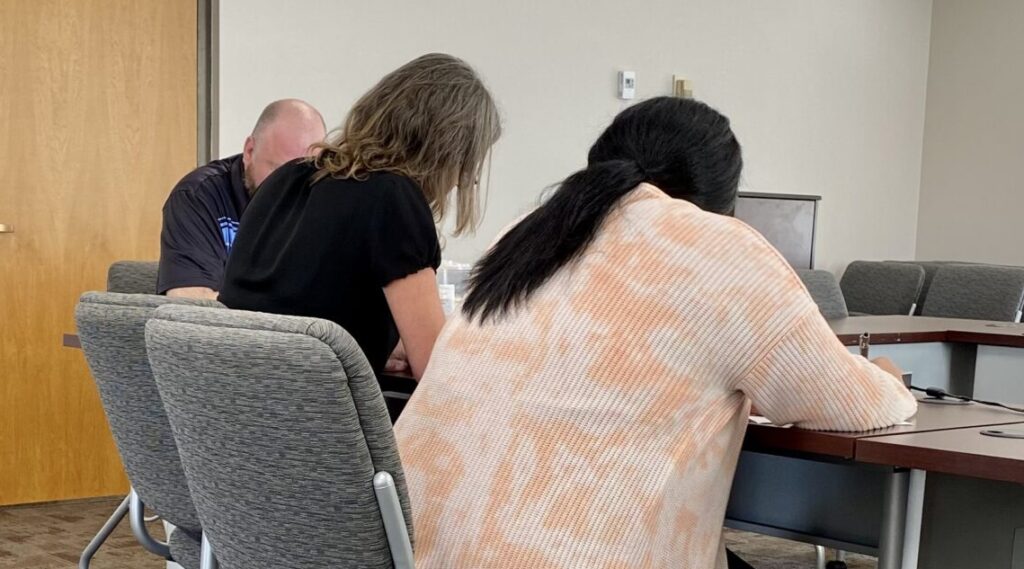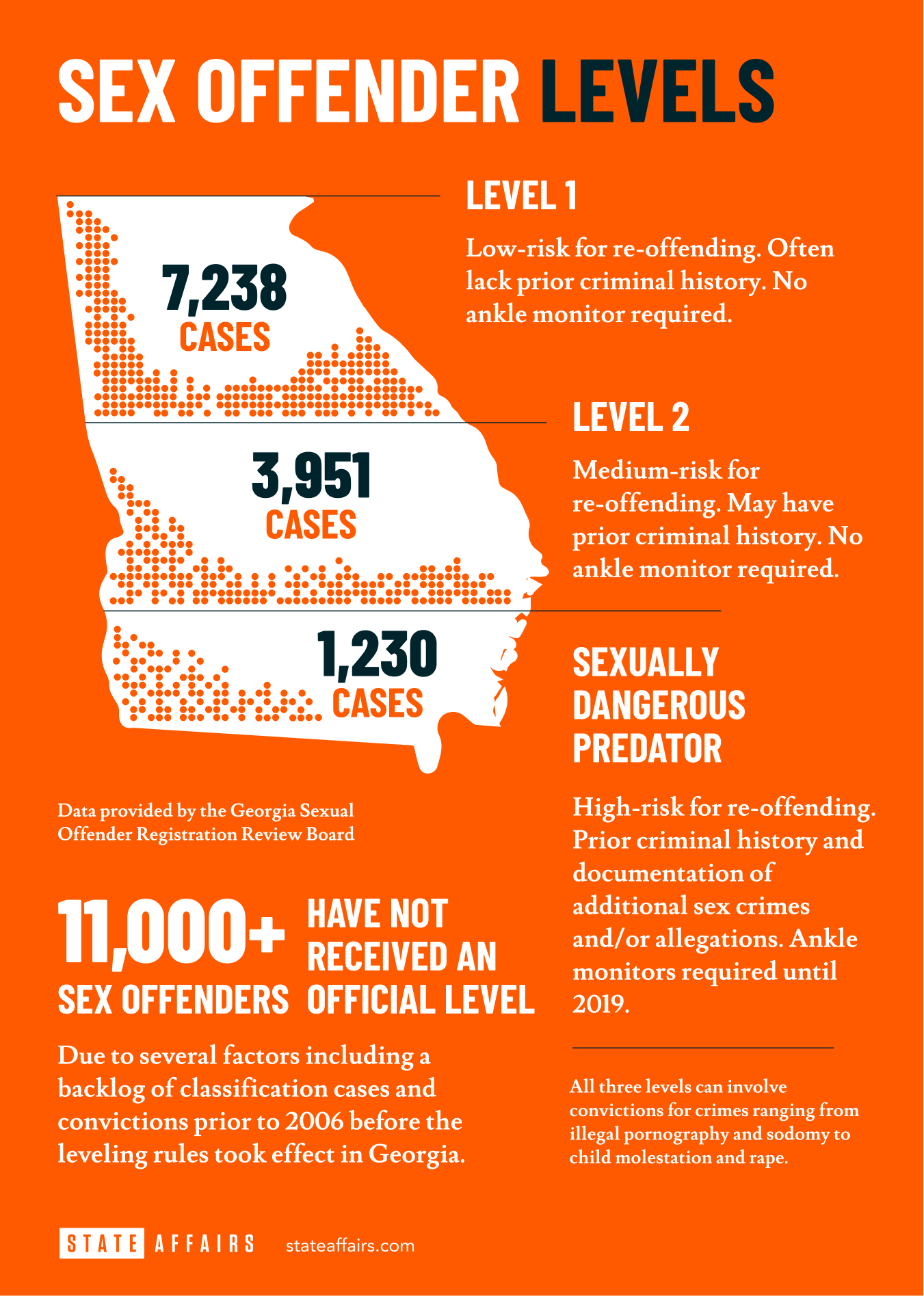Stay ahead of the curve as a political insider with deep policy analysis, daily briefings and policy-shaping tools.
Request a DemoHow Georgia evaluates thousands of sex offenders

Credit: iStock
- 1 in 23 sex offenders in Georgia are high-risk predators.
- State board uses “level” system to determine risk.
- Dozens of out-of-state sex offenders move to Georgia monthly.
How closely Georgia’s sex offenders are watched after returning to local communities post-prison depends on the work of a little-known state agency with a big case backlog.
Created in 2006, Georgia’s Sexual Offender Registration Review Board (called “SORRB”) is tasked with deciding every convicted sex offender’s risk for committing another serious crime such as rape, child molestation or possessing child pornography.
With short staffing and funds, SORRB’s investigators and volunteer board members classify dozens of sex offenders each month according to certain risk levels, dictating how much freedom they will have for years to come.

Georgia is home to around 24,000 convicted sex offenders out of a total of nearly 11 million residents.
SORRB evaluates each one of those offenders to determine their risks for reoffending. It does so by pouring over arrest warrants, police interviews with alleged victims, court records, behavior reports while incarcerated and psychological profiles. Digging into all that information quickly is a tall order.
SORRB’s 12-member board – made up of local sheriffs, district attorneys, parole officers, prison officials, attorneys, counselors and clinicians – comb through between 60 and 120 cases a month and take votes to decide offenders’ risk levels. Currently, SORRB has a backlog of about 5,000 sex offenders who have not yet received an official risk-level determination, said Tracy Alvord, SORRB’s executive director. About half of those outstanding cases involve sex offenders from out-of-state who now live in Georgia.
“The purpose of it is to identify the higher risk offenders so that we can put our resources toward those offenders,” Alvord said in a recent interview.

Roughly 1 in 23 sex offenders is classified as a “sexually dangerous predator,” marking SORBB’s highest risk category.
That rounds out to 1,230 sex predators who often have multiple convictions or accusations of sex crimes while showing a penchant for violence or preying on children, according to SORRB’s leveling criteria.
Around 7,240 sex offenders have been classified as “Level 1,” meaning they show less risk for re-offending despite convictions for illegal-porn possession, child molestation or rape. They can apply from removal from Georgia’s sex-offender registry once they’ve finished their sentences.
Another roughly 3,950 offenders received a “Level 2” classification, involving medium-risk offenders with prior criminal histories or parole violations whose convictions range from child molestation, aggravated sexual assault and statutory rape.
Sex predators must re-register twice a year for the state’s sex-offender registry. Level 1 and Level 2 offenders only have to do so once annually. Offenders of any risk level can petition courts after 10 years of good behavior post-sentence to be removed from the registry.

The risk levels help local sheriffs decide which sex offenders need to be tracked most closely in the communities where they live.
Many predators in Georgia are currently in prison or watched by parole officers with the state Department of Community Supervision. After that, it falls to local sheriffs to continue keeping tabs on sex offenders still on the state registry.
Sheriffs across the state have tight budgets and limited staff to run their sex-predator tracking divisions. Until recently, the highest-level sex predators were all required by state law to wear GPS tracking devices for life, even after completing their sentences.
That practice is now being phased out after a landmark Georgia Supreme Court ruling deemed lifetime ankle monitors as an unconstitutional form of search and seizure. By year’s end, around half of Georgia’s sex predators will be off their ankle monitors, Alvord estimates.
Additionally, more than 15,000 sex offenders in Georgia have not received a risk level at all.
That’s because their convictions occurred before SORRB’s creation in mid-2006 and, at times, due to spotty communication from some county officials that a local offender was convicted, according to Alvord.
Large conviction numbers also complicate information-sharing between a web of state and local agencies that track sex offenders. Chatham County district attorneys are quick to give information on sex convictions, Alvord said. But Fulton County, where around 10% of the state’s sex offenders reside, was slow to share convictions until recent leadership changes at the district attorney’s office, she said.
There’s also a trend of many sex offenders moving to Georgia from other states in order to become residents and request removal from the sex-offender registry, Alvord said. She estimated between 35 and 50 out-of-state sex offenders relocate to Georgia each month, adding to the state’s growing list of offenders for local police to track.
Like most state agencies, SORRB has to balance a heavy workload with limited staff and funding.
With a roughly $845,000 budget, SORRB staffs one full-time and two part-time investigators to review lengthy police reports and behavioral profiles. They send their work to six evaluators tasked with compiling risk-factor reports that can top 1,000 pages about a convicted predator.
“Not as many as we need,” Alvord said of her staff numbers. “But at least we have those.”
It’s not just SORRB that faces a staff and funding crunch. Local sheriffs and district attorneys also feel the pinch for their officers and investigators focused on sex offenders, Alvord said.
“You have district attorneys that have been extremely overwhelmed with their cases,” Alvord said. “They’re just like us: you only have so many staff that can do so much.”
Not everyone agrees SORRB should have so much power to chart the course of many sex offenders’ personal freedoms.
Joseph Park, a 69-year-old convicted child molester whose state Supreme Court case led to the ankle monitors’ removals, believes SORRB shouldn’t touch convictions like his that came before 2006 and make up the bulk of the agency’s backlog. Now, Park has his sights on fighting another legal battle over SORRB’s ability to level offenders with pre-2006 convictions, as well as challenging the foundations of Georgia’s sex-offender registry.
“I don’t see why I should be coerced into participating in updating their database,” Park said in a recent interview. “They just want to give you the opportunity to re-offend for failing to register.”
Other states besides Georgia have also seen court rulings that prohibit lifetime ankle monitoring for certain sex offenders. Courts in Missouri and New Jersey struck down lifetime ankle-monitoring laws in 2017, similar to Georgia. Same for North Carolina in 2019, where the U.S. Supreme Court ruled the state’s ankle monitors constituted a search under the U.S. Constitution’s 4th Amendment.

Alvord has her sights set on sharpening Georgia’s sex-offender tracking system to focus more on the most dangerous predators.
In the coming years, Alvord hopes to work with state lawmakers on overhauling SORRB’s level classifications to tighten up whether certain low-risk offenders should go on the state’s registry or show up only in internal law-enforcement databases. Doing so could help local authorities spend their time even more wisely on tracking Georgia’s most dangerous sex offenders, Alvord said.
Alvord would also like more funding to study how well Georgia’s risk-leveling system works compared to states like Florida, in which the kind of conviction is the basis for determining an offender’s future risk rather than the many other reports and sources that SORRB considers.
In the meantime, Alvord feels confident Georgia does better than many other states in targeting only the state’s worst sex offenders. Barrow County Sheriff Jud Smith agrees. Smith, a former SORRB board member, says having access to a wide range of criminal, behavioral and psychological background information helped him temper his own no-tolerance attitude toward sex crimes when deciding an offender’s risk level.
“It’s not arbitrary at all,” Smith said in a recent interview. “There was a formula on how they were leveled. And I won’t say the state does everything right, but they did it right with this.”
Are there any other state agencies in Georgia like SORRB that you want us to examine? Share your thoughts/tips by emailing [email protected].
Newly minted Senate Minority Leader Harold Jones II: ‘I’m not the typical back-slapping politician’
Nearly 10 years into legislative life, Sen. Harold Jones II wouldn’t change anything about the experience. “I love every minute of it. Even when I hate it, I love it,” the 55-year-old Augusta Democrat told State Affairs. Come January, Jones will add another role to his legislative duties: Senate minority leader, a job held for …
Gov. Kemp calls on state agencies to be fiscally restrained amid record $16.5B surplus
The Gist Gov. Brian Kemp asked the state’s 51 government agencies for continued fiscal restraint when drafting their amended fiscal year 2025 and 2026 budgets. Most agencies adhered to his request even as the state’s general fund surplus hit a record $16.5 billion last month. Forty-five agencies, excluding state courts, followed the governor’s instructions to …
Georgia defies bomb threats as election chief declares a “free, fair and fast” vote amid record turnout
ATLANTA – Despite dealing with over 60 bomb threats, Georgia’s election chief said Tuesday the state’s general election went smoothly. Georgia had a record turnout with nearly 5.3 million people voting, Secretary of State Brad Raffensperger told reporters. Election officials in the state’s 159 counties have until 5 p.m. to certify votes. “We had a …
In the (state)house: Meet the newest members of the Georgia legislature
When lawmakers reconvene at the state Capitol on Jan. 13, there’ll be a cadre of new faces in the 236-member Georgia General Assembly, one of the nation’s largest state legislatures. All 236 statehouse seats were up for election this year. Most candidates ran unopposed. Incumbents in contested races easily kept their seats, with the exception …




